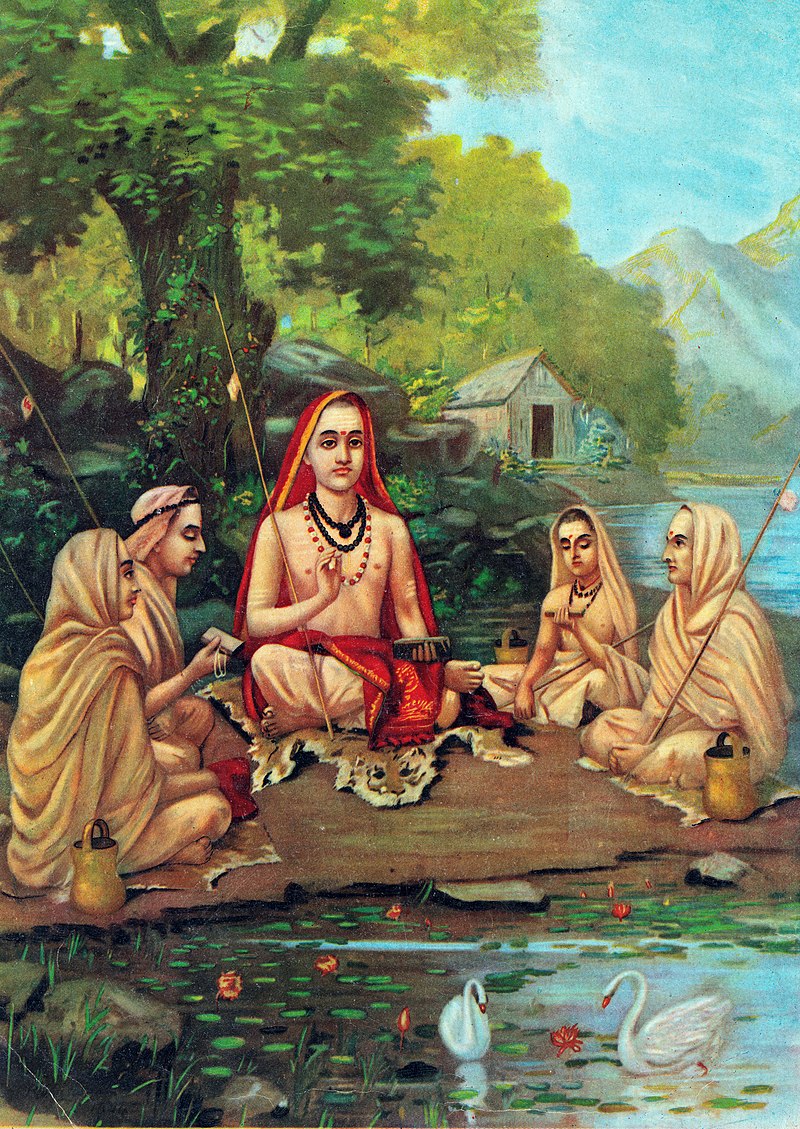5 XIII, 1 ff.
Picture: Masya pulling Manu's and his family's boat, source: pinterest.com, referring to dwarkadheeshvastu.com, access date: February 09, 2024.
1.
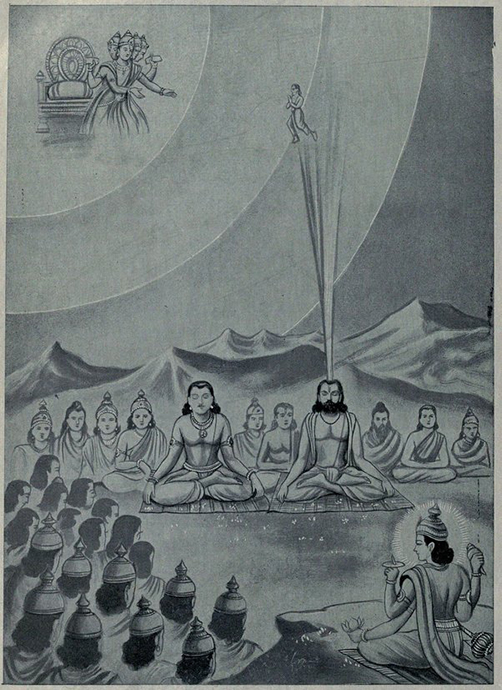 The picture shows the prayers of the Brahmins. To send King Ikṣvāku to heaven, source: www.quora.com, date of access: February 9, 2024.
The picture shows the prayers of the Brahmins. To send King Ikṣvāku to heaven, source: www.quora.com, date of access: February 9, 2024.31
…wise Uśaṇā; look at me. …” In the Kauṣītaki Up. (III), Indra says to Pratardana “I am the vital breath. I am the conscious self. Worship me as life, as breath. He who worships me as life, as immortality, obtains full life in this world. He obtains immortality and indestructibility in the heavenly regions.”1 In the Gītā, the author says: “Delivered from passion, fear and anger, absorbed in Me, taking refuge in Me, many purified by the austerity of wisdom have attained to My state of being.”2 The ego holds something other than itself, to which it should abandon itself. In this abandonment consists its transfiguration. A liberated soul uses his body as a vehicle for the manifestation of the Eternal. The divinity claimed by Kṛṣṇa is the common reward of all earnest spiritual seekers. He is not a hero who once trod the earth and has now left it, having spoken to His favorite friend and disciple, but is everywhere and in every one of us, as ready to speak to us personality but the indwelling spirit, an object for our spiritual consciousness.
God is never born in the ordinary sense. Processes of birth and incarnation which imply limitation do not apply to Him. When the Lord is said to manifest Himself at a particular…
---------------
1 Ś., commenting on this, observes: “That is, Indra, a deva, looking on his own self as the Supreme Brahman by the vision od the sages according to the Śāstras, says, ‘Know me’ just as the sage Vāmadeva seeing the same truth, felt, ‘I am Manu, I am Sūrya.’ In the Śṛuti (that is the Bṛhadāraṇyaka Up.) it is said, ‘The worshipper becomes one with the god he truly sees.’ ”
2 IV, 10. Jesus spent his life in solitary prayer, meditation and service, was tempted like any of us, had spiritual anguish, when he lost the sense of the presence of God, cried out, “My God, my God, why hast thou forsaken me?” (Mark xv, 34). Throughout, he felt his dependence on God. “The father is greater than I”: (John xiv, 28). “Why callest thou me good? None is good, save one, even God” (Luke xviii, 19). “But of that day and that hour knoweth on one, not even the angels in heaven, neither the Son but the Father” (Mark xiii, 32). “Father, into Thy hands I commend my spirit” (Luke xxiii, 46). Though conscious of his imperfections, Jesus recognized the grace and love of God and willingly submitted himself entirely to Him, he attained to a divine status. “I and the Father are one” (John x, 30).
Dattātreya, source: www.pinterest.com refer to hinducosmos.tumblr.com, access date: Feb.10, 2024.
32
…time, on a particular occasion, it only means that it takes place with reference to a finite being. In Chapter XI the whole world is seen in God. The subjective and the objective processes of the world are only the expressions of the higher and lower natures of the Supreme; yet in whatever is glorious, beautiful and strong, God’s presence becomes more manifest. When any finite individual develops spiritual qualities and shows large insight and charity, he sits in judgement on the world and starts a spiritual and social upheaval and we say that God is born for the protection of the good, the destruction of the evil and the establishment of the kingdom of righteousness. As an individual, Kṛṣṇa is one of millions of forms through which the Universal Spirit manifests Itself. The author of the Gītā mentions Kṛṣṇa of history as one of many forms along with his disciple Arjuna.1 The avātara is the demonstration of man’s spiritual resources and latent divinity. It is not so much the contraction of Divine majesty into the limits of the human frame as the exaltation of human nature to the level of Godhead by its union with the Divine.
Theism, however, makes out that Kṛṣṇa is an incarnation (avataraṇa) or descent of the Divine into the human frame. Though the Lord knows no birth or change, He has many times been born. Kṛṣṇa is the human embodiment of Viṣṇu. He is the Supreme who appears to the world as though born and embodied.2 The assumption of human nature by the Divine Reality, like the creation of the world, does not take away from or add to the integrity of the Divine.
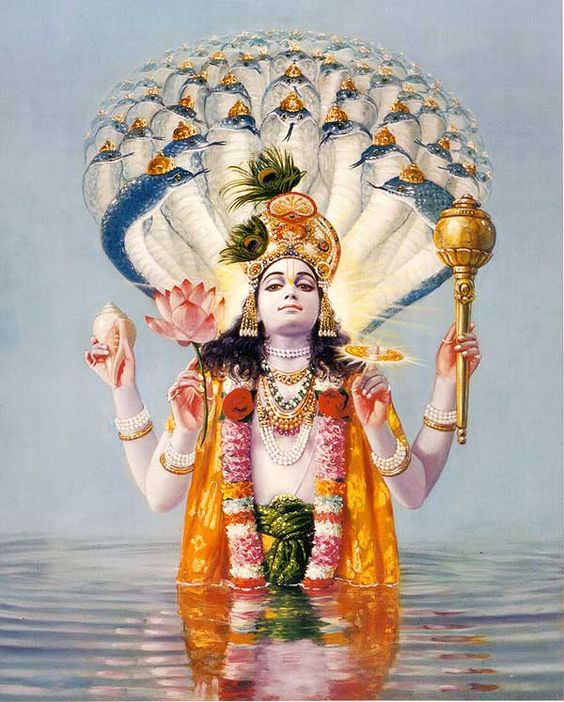 Vishnu or Nārāyaṇa (नारायण), source: www.pinterest.com, access date: Aug.4, 2018.
Vishnu or Nārāyaṇa (नारायण), source: www.pinterest.com, access date: Aug.4, 2018.---------------
1 X, 37.
2 Ś. writes: sa ca bhagavān jñānaiśvaryaśaktibalavīryatejobhih, sadā sampannaḥ, triguṇātmikāṁ vaiṣṇavīṁ svāṁ māyāṁ mūlaprakṛtīṁ vaśīkṛtya, ajo avyayo bhūtānām īśvaro nityaśuddhabuddhamuktasvabhāvopi san svamāyayā dehavān iva jāta iva, lokānugrahaṁ kurvanivalakṣyate. aṁśena sambabhūva does not mean that Kṛṣṇa is born of a part or is a partial incarnation. Ānandagiri interprets aṁśena to mean “in a phenomenal form created by his own will” svecchānirmitena māyāmayeṇa svarūpeṇa. While the Apostle’s Creed lays stress on the human nature of the Son of God, “who was conceived by the Holy Ghost, born of the Virgin Mary, suffered under Pontius Pilate, was crucified, dead and buried,” the Nicene Creed adds that he “came down from heaven and was made flesh.” This coming down or descent of God into flesh is the avataraṇa.
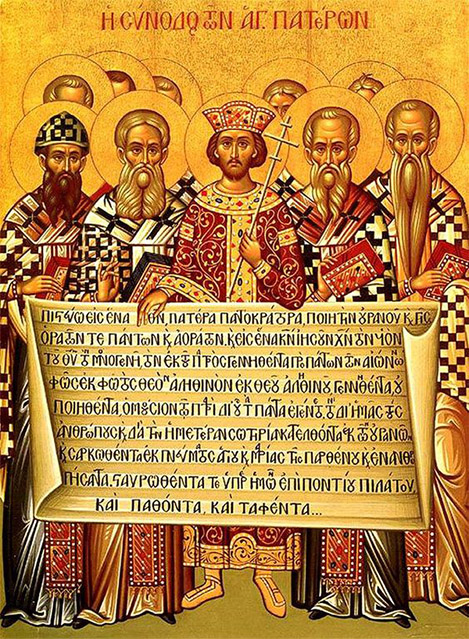 Icon depicting the Emperor Constantine, accompanied by the bishops of the First Council of Nicaea (A.D.325), holding the Niceno-Constaninoplitan Creed of A.D.381, source: www.pinterest.com refer: catholicfaithstore.com, access date: Feb.11. 2024
Icon depicting the Emperor Constantine, accompanied by the bishops of the First Council of Nicaea (A.D.325), holding the Niceno-Constaninoplitan Creed of A.D.381, source: www.pinterest.com refer: catholicfaithstore.com, access date: Feb.11. 2024
33
Creation and incarnation both belong to the world of manifestation and not to the absolute Spirit.1
If the Infinite God is manifested in finite existence throughout time, then Its special manifestation at one given moment and through the assumption of one single human nature is but the free fulfilment of that same movement by which the Divine plenitude freely fulfils itself and inclines towards the finite. It does not raise any fresh problem apart from that of creation. If a human organism can be made in the image of God, if new patterns can be woven into the stuff of repetitive energy, if eternity can be incorporated in these ways into succession, then Divine Reality can express His absolute mode of being in and through a completely human organism. The scholastic theologians tell us that God is present in the creatures, “by essence, presence, power.” The relation between the Absolute, infinite, self-existent and immutable and the finite human individual who is enmeshed in the temporal order is unimaginably intimate though difficult to define and explain. In the great souls we call incarnations, God who is responsible for the being and dignity of man has more wonderfully renewed it. The penetration of successiveness by the Eternal which is present in every event of the cosmic is manifested in a deeper sense in the incarnations. When once God has granted us free will, He does not stand aside leaving us to make or unmake ourselves. Whenever by the abuse of freedom unrighteousness increases and the world gets stuck in a rut, He creates Himself to lift the world from out of its rut and set it on new tracks. Out of His love He is born again and again to renew the work of creation on a higher plane. According to a passage in the M.B., the Supreme who is ever ready to protect the worlds has four forms. One of them dwells on earth practicing penance; the second keeps watch over the actions of erring humanity; the third is engaged in activity in the world of men, and the fourth is plunged in the slumber of a thousand…
---------------
1 Cp. Hooker: “This admirable union of God with man can enforce in that higher nature no alternation because with God there is nothing more natural than not to be subject to any change.” Ecclesiastical Polity (1888 ed.), vol. ii, p. 234.
_03.jpg) Of the Laws of Ecclesiastical Politie (edition published in A.D.1666), source: en.wikipedia..org, date of search: February 12, 2024.
Of the Laws of Ecclesiastical Politie (edition published in A.D.1666), source: en.wikipedia..org, date of search: February 12, 2024.
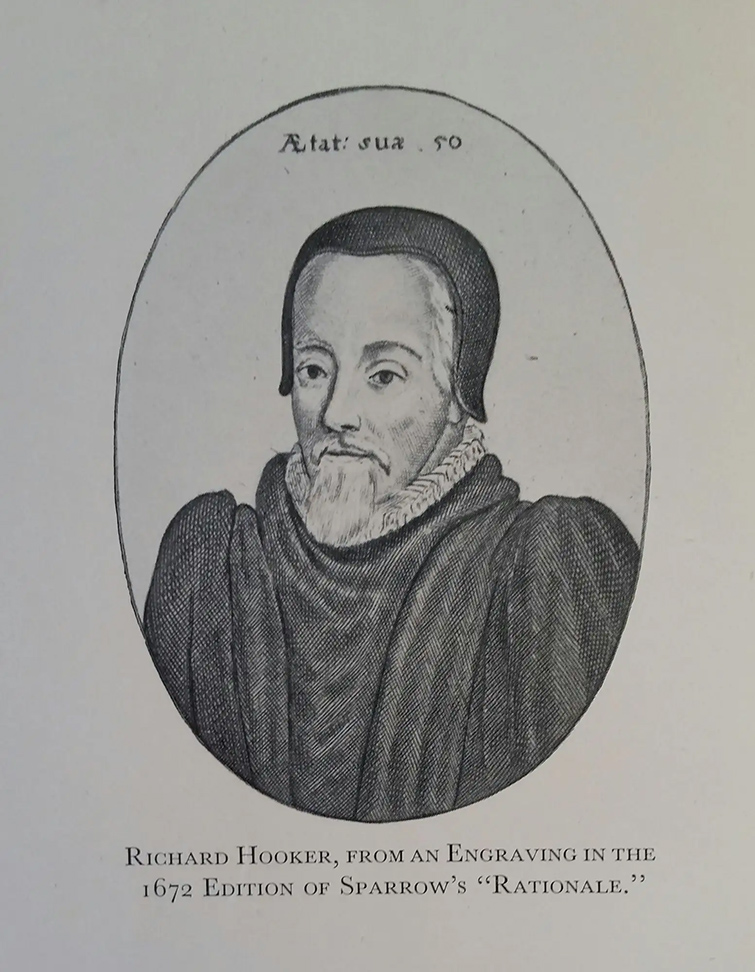 Richard Hooker, source: www.staroftheseabooks.com, access date: Feb.13, 2024.
Richard Hooker, source: www.staroftheseabooks.com, access date: Feb.13, 2024.34
…years.1 Absolute impassivity is not the only side of Divine nature. The Hindu tradition makes out that the avatāras are not confined to the human level. The presence of pain and imperfection is traced not to man’s rebellious will but to a disharmony between the creative purpose of God and the actual world. If suffering is traced to the “fall” of man, we cannot account for the imperfections of innocent nature, for the corruption that infects all life, for the economy of disease. The typical question, Why is there cancer in the fish? cannot be avoided. The Gītā points out that there is a Divine Creator who imposes His forms on the abysmal void. Prakṛti is the raw material, the chaos out of which order is to be evolved, a night which is to be illumined. In the struggle between the two, whenever a deadlock is created, there is Divine interference to release the deadlock. Besides, the idea of one unique revelation is hardly consistent with our present views of the universe. The tribal God gradually became the God of the earth and the God of the earth has now become the God of the universe, perhaps only one of many universes. It is inconceivable that the Supreme is concerned only with one part of one of the smallest of planets.
The theory of avatāra is an eloquent expression of the law of the spiritual world. If God is looked upon as the savior of man, He must manifest Himself, whenever the forces of evil threaten to destroy human values. An avatāra is a descent of God into man and not an ascent of man into God, which is the case with the liberated soul. Though every conscious being is such a descent, it is only a veiled manifestation. There is a distinction between the self-conscious being of the Divine and the same shrouded in ignorance.
The fact of descent or avataraṇa indicates that the Divine is not opposed to a full vital and physical manifestation. We can live in the physical body and yet possess the full…
---------------
1 Caturumūrtir ahaṁ śavśal lokatrāṇārtham uḍvataḥ
ātmānaṁ pravibhajveha lokānāṁ hitam ādadhe
ekāmūrtis tapascaryāṁ kurute me bhuvi sthitā
aparā paśyati jagat kurvāṇaṁ sādhvasādhunī
aparā kurute karma mānuṣaṁ lokam āsritā
s’ ete caturthī tvaparā nidrāṁ varṣasahasrikīṁ.
Droṇaparva, XXIX, 32-34.
35
…truth of consciousness. Human nature is not a fetter but can become an instrument of divine life. Life and body with us, ordinary mortals, remain ignorant, imperfect and impotent means of expression but they need not always be so. The Divine Consciousness uses these for Its purpose while the unfree human consciousness has not this absolute control, over the physical, vital and mental forces.
Though the Gītā accepts the belief in avatāra as the Divine limiting Himself for some purpose on earth, possessing in His limited form the fullness of knowledge, it also lays stress on the eternal avatāṛa, the God in man, the Divine consciousness always present in the human being. The two views reflect the transcendent and the immanent aspects of the Divine and are not to be regarded as incompatible with each other. The teacher, who is interested in the spiritual illumination of the human race, speaks from the depths of the Divine in him. Kṛṣṇa’s avatāra is an illustration of the revelation of the Spirit in us, the Divine hidden in gloom. According to the Bhāgavata,1 “at midnight, in the thickest darkness, the Dweller in every heart revealed Himself in the divine Devakī for the Lord is the self hidden in the hearts of all beings.”2 The glorious radiance arises from the blackest of black nights. In mysteries and revelations the night is rich. The presence of night does not make the existence of light less real. Indeed but for night there could be no human consciousness of light. The meaning of the birth of Kṛṣṇa is the fact of redemption in the dark night. In the hour of…
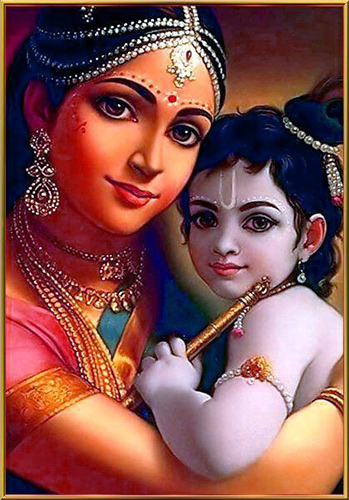
Devakī and Lord Kṛṣṇa, source: loveshayariimages.in, access date: Feb.14, 2024.
---------------
1 niśīthe tamodbhūte jāyamāne janārdane
devakyāṁ devarūpiṇyāṁ viṣṇuḥ sarvaguhāśayaḥ….
vasydevagṛhe sākṣāt bhagavān puruṣaḥ paraḥ janiṣyate. Bhāgavata.
Cp. What is said about the Incarnation of Jesus Christ: “Whilst all things were in quiet silence and night was in the midst of her swift course; thine Almighty Word leapt down from heaven out of thy royal throne. Alleluia.” The doctrine of the Incarnation agitated the Christian world a great deal. Arius maintained that the Son is not the equal of the Father but created by Him. The view that they are not distinct but only different aspects of one Being is the theory of Sabellius. The former emphasized the distinctness of the Father and the Son and the latter their oneness. The view that finally prevailed was that the Father and the Son were equal and of the same substance; they were, however, distinct persons.
2 X, 20; XVIII, 61.
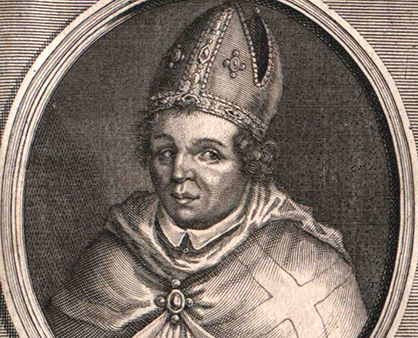 Arius, source: https://catholicherald.co.uk, access date: Feb.16, 2024.
Arius, source: https://catholicherald.co.uk, access date: Feb.16, 2024.36
…calamity and enslavement the Saviour of the world is born.
Kṛṣṇa is said to be born of Vasudeva and Devakī. When our sattva nature is purified,1 when the mirror of understanding is cleansed of the dust of desire, the light of pure consciousness is reflected in it. When all seems lost, light from heaven breaks, enriching our human life more than word can tell. A sudden flash, an inward illumination we have and life is seen fresh and new. When the Divine birth takes place within us, the scales fall from our eyes, the bolts of the prison open. The Lord abides in the heart of every creature and when the veil of that secret sanctuary is withdrawn, we hear the Divine voice, receive the Divine light, act in the Divine power. The embodied human consciousness is uplifted into the unborn eternal.2 The incarnation of Kṛṣṇa is not so much the conversion of Godhead into flesh as the taking up of manhood into God.
The teacher slowly guides his pupil to attain the status which he has, mama sādharmyam. The pupil, Arjuna, is the type of the struggling soul who has not yet received the saving truth. He is fighting with the forces of darkness, falsehood, limitation, and mortality which bar the way to the higher world. When his whole being is bewildered, when he does not know the valid law of action, he takes refuge in his…
---------------
1 sattvaṁ viśuddhaṁ vasudeva śabditam. Bhāgavata. Devakī is daivī prakṛti, divine nature.
2 This, to my mind, is the meaning of the Christian doctrine of resurrection. The physical resurrection of Jesus is not the important thing but the resurrection of the Divine. The rebirth of man as an event that happens within his soul, resulting in a deeper understanding of reality and a greater love for God and man, is the true resurrection which lifts human life to an awareness of its own Divine content and purpose. God is perpetual creativity, ceaseless action. He is the Son of Man for in man is God reborn. When the veil between the eternal and the temporal is lifted, man walks with God and as He directs.
Cp. Angelus Silesius: Though Christ a thousand times
In Bethlehem be born,
If He’s not born in thee
Thy soul is still forlorn.
The Cross on Golgotha
Will never save thy soul,
The Cross in thine own heart
Alone can make thee whole
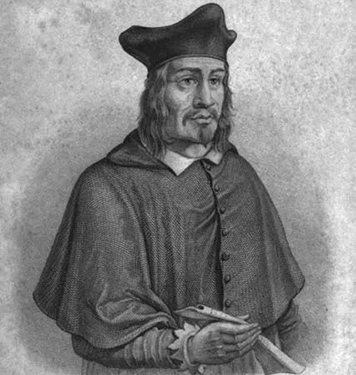 Angelus Silesius, source: www.britannica.com, access date: Feb.17, 2024.
Angelus Silesius, source: www.britannica.com, access date: Feb.17, 2024.37
...higher self, typified as Kṛṣṇa, the world teacher, jagadguru1 and appeals for the grace of enlightenment. “I am thy disciple. Illumine my consciousness. Remove what is dark in me. Give me that which I have lost, a clear rule of action.” The rider in the chariot of the body is Arjuna but the charioteer is Kṛṣṇa and He has to guide the journey. Every individual is a pupil, an aspirant for perfection, a seeker of God and if he seeks earnestly, with faith, God the goal becomes God the guide. It is of little moment, so far as the validity of the teaching is concerned, whether the author is a figure of history or the very god descended into man, for the realities of spirit are the same now as they were thousands of years ago and differences of race and nationality do not affect them. The essential thing is truth or significance; and the historical fact is nothing more than the image of it.2
1.
6. The Status of the World and the Concept of Māyā
If the fundamental form of the Supreme is nirguṇa, qualityless and acintya, inconceivable, the world is an appearance which cannot be logically related to the absolute. In the unalterable eternity of Brahman, all that moves and evolves is founded. By It they exist, they cannot be without It, though It causes nothing, does nothing, determines nothing.
---------------
1 Cp. ajñānatimirāndhasya jñānāñjanaśalākayā
cakṣur unmīlitaṁ yena tasmai śri gurave namaḥ.
I bow to the divine teacher, who opens the eyes of one blinded by the disease of ignorance by means of the principle (collyrium) of knowledge.
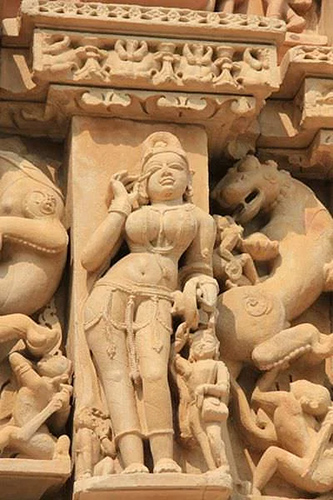 Statue of a woman applying Kajal (Collyrium) to her eyes at a Jain temple in Khajuraho, Madhya Pradesh, Bharat, source: www.worldhistory.org, access date: February 17, 2024.
Statue of a woman applying Kajal (Collyrium) to her eyes at a Jain temple in Khajuraho, Madhya Pradesh, Bharat, source: www.worldhistory.org, access date: February 17, 2024.
2 Cp. Spinoza: “It is not in the least needful for salvation to know Christ according to the flesh; but concerning that so-called eternal Son of God (de aeterno illo Dei filio), that is, God’s eternal wisdom, which is manifested in all things, and chiefly in the mind of man, and most particularly in Christ Jesus, the case is far otherwise. For without this no man can arrive at a state of blessedness, inasmuch as nothing else can teach him what is true or false, what is good or evil.” Thus Spinoza distinguishes between the historical Jesus and the ideal Christ. The divinity of Christ is a dogma that has grown in the Christian conscience. Christological doctrine is the theological explanation of the historic fact. Loisy observes: “The Resurrection of Jesus was not the last step of His terrestrial career, the last act of His ministry amongst men, but the first article of the faith of the Apostles and the spiritual foundation of Christianity.” Maude Petre: Loisy (1944), pp. 65-66.
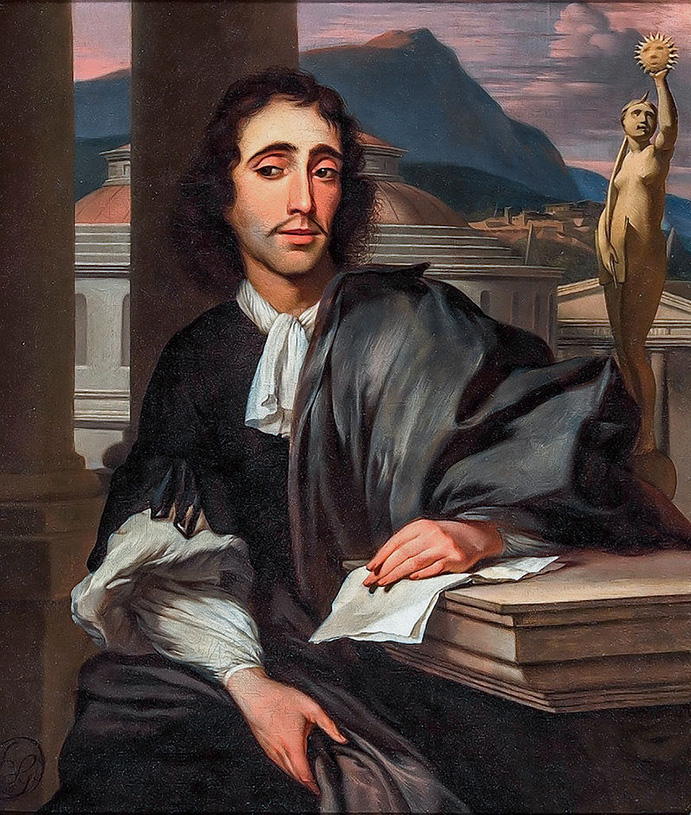 The portrait of Baruch Spinoza by Barend Graat, 1666, source: en.wikipedia.org, access date: Feb.18, 2023.
The portrait of Baruch Spinoza by Barend Graat, 1666, source: en.wikipedia.org, access date: Feb.18, 2023.
38
While the world is dependent on Brahman, the latter is not dependent on the world. This one-sided dependence and the logical inconceivability of the relation between the Ultimate Reality and the world are brought out by the word, “māyā.” The world is not essential being like Brahman; nor is it mere non-being. It cannot be defined as either being or non-being.1 The sudden discovery through religious experience of the ultimate reality of spirit inclines us sometimes to look upon the world as an illusion rather than as a misapprehension or a misconstruction. Māyā does not imply that the world is an illusion or is non-existent absolutely. It is a delimitation distinct from the unmeasured and the immeasurable. But why is there this delimitation? The question cannot be answered, so long as we are at the empirical level.
In every religion, the Supreme Reality is conceived as infinitely above our time order, with its beginning and end, its movements and fluctuations. God, in the Christian religion, is represented as without variableness or shadow of turning. He dwells in the eternal now seeing the end from the beginning. If this were all, there would be an absolute division between the divine life and this pluralistic world, which would make all communication between the two impossible. If the Supreme Reality were unique, passive and immobile, there would be no room for time, for movement, for history. Time, with its processes of change and succession, would become a mere appearance. But God is a living principle, a consuming fire. It is not a question of either an Absolute with an apparent multiplicity or a living God working in this pluralistic universe. The Supreme is both this and that. Eternity does not mean the denial of time or of history. It is the transfiguration of time. Time derives from eternity and finds fulfilment in it. In the Bhagavadgītā, there is no antithesis between eternity and time. Through the figure of Kṛṣṇa, the temporal movement is related to the inmost depths of eternity.
The Spirit which transcends all dualities, when looked at from the cosmic end becomes sundered into the transcendental subject facing the transcendental object. Subject and
---------------
1 sadasadbhyām anirvacanīyam.
39
Object are the two poles of the one Reality. They are not unrelated. The principle of objectivity, mūlaprakṛti, the unmanifested (avyakta) potentiality of all existence is of the very nature of the creative logos, Īśvara. The eternal “I” confronts the pseudo-eternal “not I,” Nārāyaṇa broods over the waters. As the “not-I,” prakṛti, is reflection of the Self, it is subordinate to the Self. When the element of negation is introduced into the absolute, its inwardness is unfolded in the process of becoming. The original unity becomes pregnant with the whole course of the world.
Cosmic process is the interaction between the two principles of being and non-being. God is the upper limit with the least affection by and complete control of non-being and matter or prakṛti is the lower limit with the least affection be being. The whole cosmic process is the Supreme God working on prakṛti which is conceived as a positive entity is evil. Only in God is it completely penetrated and overcome. In the rest of the created world, it is there in some degree or other, obscuring the light.
The Gītā does not uphold a metaphysical dualism; for the principle of non-being is dependent on being. Non-being is a necessary moment in reality for the unfolding of the Supreme. If the world is what it is, it is because of the tension. The world of time and change is ever striving to reach perfection. Non-being which is responsible for the imperfections is a necessary element in the world, for it is the material in which the ideas of God are actualized.1 The spiritual whole. When the whole world is delivered from bondage, when it is lifted into incorruption, when it becomes completely illuminated, the purpose of the Supreme is realized and the world is restored to its origin in pure Being, above all distinctions.
Why is there non-being? Why is there the fall or the precipitation from absolute being to becoming? This is to ask why is there the world with its perpetual strife between being and non-being? Absolute being, the one Godhead, is behind…
---------------
1 Cp. Proclus who regards matter as a “child of God” which is bound to be transformed into spirit.
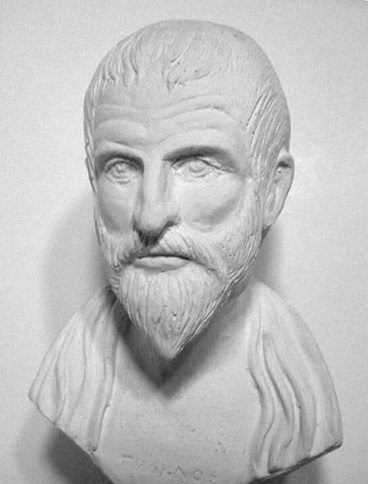
Proclus, source: dougballiett.nyc, access date: Feb.19, 2024. 40
…and beyond the world and in the world; He is also the Supreme Living God, loving the world and redeeming it by His grace. Why is the world what it is with its graduated hierarchy? We can only say, it is the nature of the Supreme to express Itself in this way. We cannot account for the fact of the world but can only construe its nature, which is a strife between being and non-being in the process of becoming. Pure being is above the world and pure non-being is below the lowest existent. If we go lower still we have nothing, it is absolute non-entity. In the world of true becoming, saṁsāra, we have the conflict between the two principles of being and non-being.
The first product of the interaction is the cosmic egg (brahmāṇḍa) which includes within itself the totality of manifested being. All later developments are contained within it in a germinal form. It contains the past, the present and the future in a supreme now. Arjuna sees the whole Viśvarūpa, world-form, In one vast shape. He sees the form of the whole sky and the universe, worlds coursing through it like cataracts.
Those who look upon the Supreme as impersonal and relationless regard the conception of Īśvara with his power of self-manifestation as the result of ignorance (avidyā).1 The power of thought that produces forms which are transient and therefore unreal compared with the Eternal Reality, this power of producing appearances is called avidyā. But avidyā is not something peculiar to this or that individual. It is said to be the power of self-manifestation possessed by the Supreme. The Lord says that though He, in reality, is birthless, He comes to birth by His own power ātmamāyayā.2 Māyā is derived from the root, mā, to form, to build, and…
---------------
1 Ś. Says: “The names and forms imagined to exist in the Supreme Iśvara as a result of the ignorance of the nature of the Ātman, of which it is not possible to say whether they are different. Or non-different from the Supreme are in Śṛuti and Śmṛti texts called māyā, śakti, prakṛti of the all knowing Parameśvara.” S.B., II, 1, 14.
Adi Shankara with Disciples, by Raja Ravi Varma (1904), source: en.wikipedia.org, retrieved date: July 9, 2019.
1.
2 IV, 6. “The Supreme Lord chose to sport in the exercise of His power of Yoga.”
Bhagavān api rantuṁ manascakre yogamāyām upaśṛtaḥ. Bhāgavata, X, 29, 1. Divine activity is not undertaken for the fulfilment of any purpose of his own, because God is nityatrpta. This feature of disinterestedness is brought out by the use of the world sport. Lokavat tu līlākaivalyam. Brahma Sūtra, II, 1, 33. Rādhā Up. Says that the One God is eternally at play in the varied activities of the world. eko devo nityalīlānuraktaḥ, IV, 3
41
…originally meant the capacity to produce forms. The creative power by which God fashions the universe is called yoga māyā. There is no suggestion that the forms, the events and the objects produced by māyā or the form-building power of God, the māyin, are only illusory.
Māyā is sometimes said to be the source of delusion (moha). “Deluded by these threefold modes of nature (guṇa), this whole world does not recognize Me who am above them and imperishable.”1 Through the force of māyā we have a bewildering partial consciousness which loses sight of the reality and lives in the world of phenomena. God’s real being is veiled by the play of prakṛti and its modes. The world is said to be deceptive because God hides Himself behind His creation. The world is not a deception but the occasion for it. We must shatter all forms, get behind the veil to find the reality. The world and its changes constitute the self-concealment of God (tirodhāna) or obscuring of the Creator by His creation. Man is inclined to turn towards the objects of the world instead of directing his mind to the Creator. God seems to be the great deceiver as He creates the world and its sense objects and turns our senses outward.2 The proneness to self-deception lies in the desire for the things glamour of the world casts its spell on us and we become slaves to its prizes. The world or objectivized nature or saṁsāra is fallen, enslaved, alienated and it is full of suffering, as alienation from inward being is suffering. When it is said that “this divine māyā of mine is hard to over-….
---------------
1 VII, 13. Cp. Nārada Pañcarātra. “One only is the Lord always, in all and in each. All beings come into existence by His action; but they are deceived by His māyā.” II, 1, 22. In M.B. it is said: “O, Nārada, that which you see is the māyā which has been created by the Me. Do not think that I possess the qualities, which are to be found in the created world.”
Māyā hy eṣa mayā sṛṣtā yan māṁ paśyasi Nārada
sarvabhūtaguṇair yuktaṁ naiva tvaṁ jñātum arhasi.
Śāntiparva, 339, 44.
2 Kaṭha Up., IV, 1.
42
…-come,” it means that we cannot easily pierce behind the universe and its activities.1
We may here distinguish the different senses in which the word “māyā” is used and indicate its place in the Gītā. (1) If the Supreme Reality is unaffected by the events of the world, then the rise of these events becomes an inexplicable mystery. The author of the Gītā does not use term, “māyā,” in this sense, however much it may be implied in his views. The conception of a beginning-less, and at the same time unreal, avidyā causing the appearance of the world, does not enter the mind of the author. (2) The personal Īśvara is said to combine within Himself, sat and asat, the immutability of brahman as well as the mutation of becoming.2 Māyā is the power which enables Him to produce mutable nature. It is śakti or the energy of Īśvara, or ātmavibhūti, the power of self-becoming. Īśvara and Māyā in this sense are mutually dependent and beginning-less.3 This power of the Supreme is called māyā in the Gītā.4 (3) Since the Lord is able to produce the universe by means of the two elements of His being, prakṛti and puruṣa, matter and consciousness, they are said to be māyā (higher and lower) of God.5 (4) Gradually, māyā comes to mean the lower prakṛti, since puruṣa is said to be the seed which the Lord casts into the womb of prakṛti for the generation of the universe. (5) As the manifested world hides the real from the vision of mortals, it is said to be delusive in character.6 The world is not an illusion, though by regarding it as a mere mechanical determination of nature unrelated to God, we fail to perceive its Divine essence. It then becomes a source of delusion. The Divine māyā becomes avidyāmāyā. It is so, however, only all and controls it, it is vidyāmāyā. God seems to be enveloped in the immense cloak of māyā.7 (6) Since the world is only…
---------------
1 VII, 14; see also Īśa Up., 16.
2 IX, 19.
3 See Śāṇḍilya Śūtra, II, 13 and 15; Śvetāśvatara Up., IV, 10.
4 XVIII, 61; IV, 6.
5 IV, 16.
6 VII, 25 and 14.
7 Māyā which does not produce avidyā is said to be sāttvikī māyā. When it is polluted, it breeds ignorance or avidyā. Brahman reflected in the former is Īśvara, while that reflected in the latter is jīva, or the individual self. This is later Vedānta; see Pañcadaśi, I, 15-17. Gītā is not aware of this view.
43
…an effect of God, who is the cause and since everywhere the cause is more real than the effect, the world as effect is said to be less real than God the cause. This relative unreality of the world is confirmed by the self-contradictory nature of the process of becoming. There is a struggle of opposites in the world of experience, and the real is above all opposites.1
--------------
1 II 45; VII, 28; IX, 33.



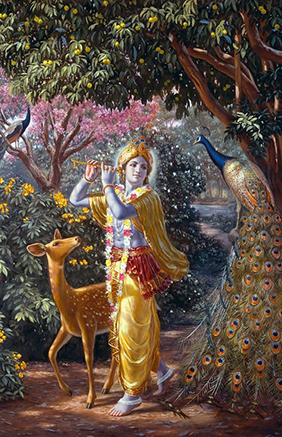
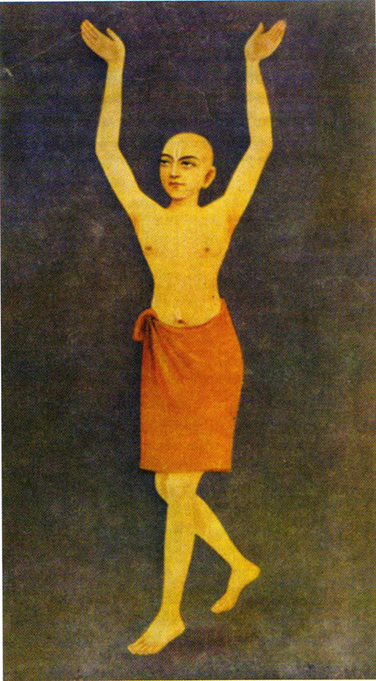
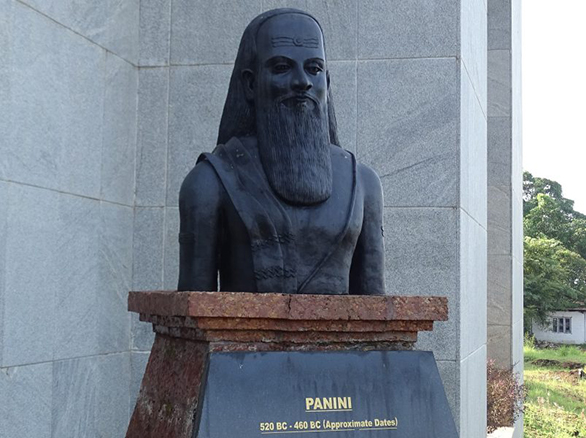
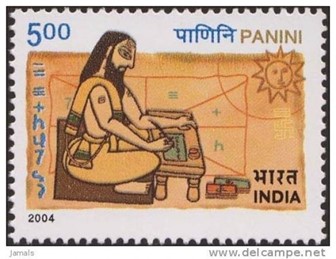
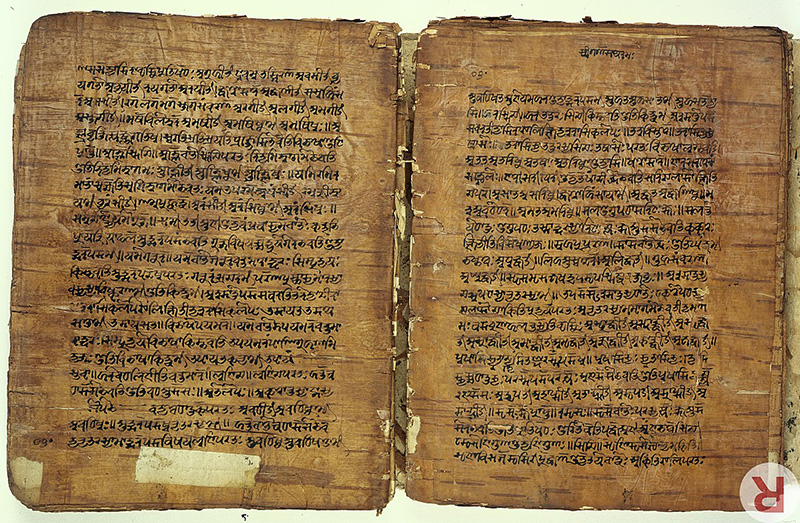

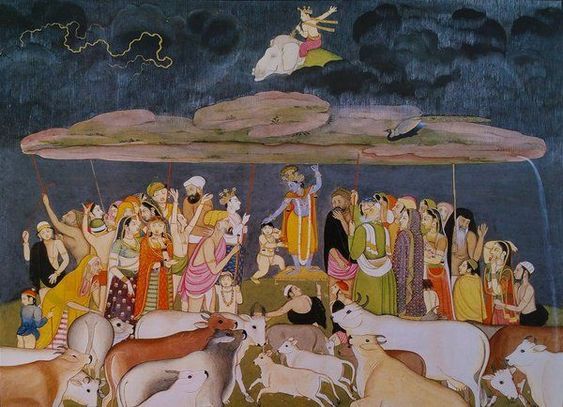
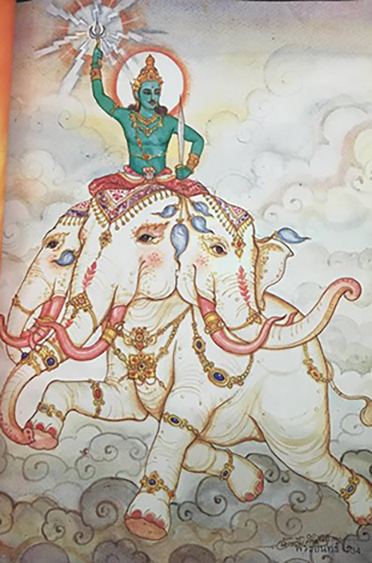
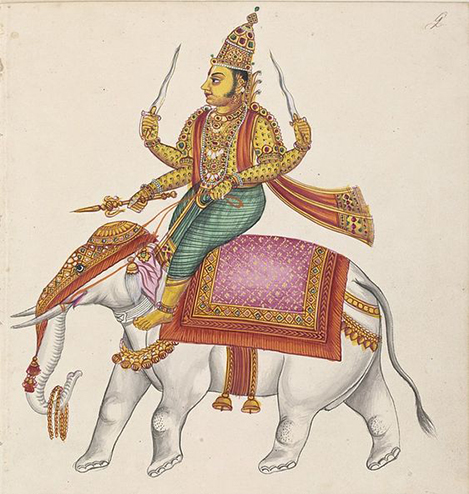
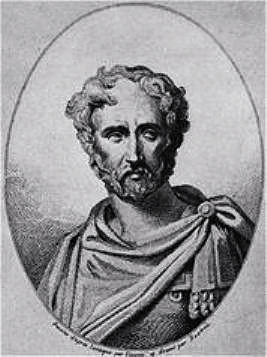
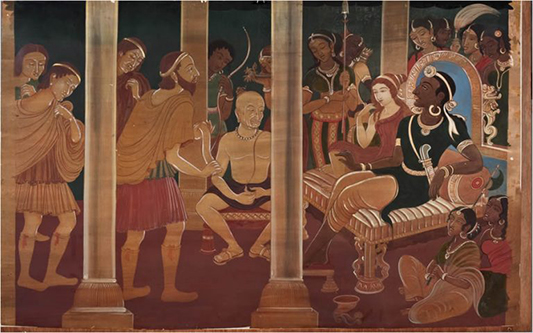

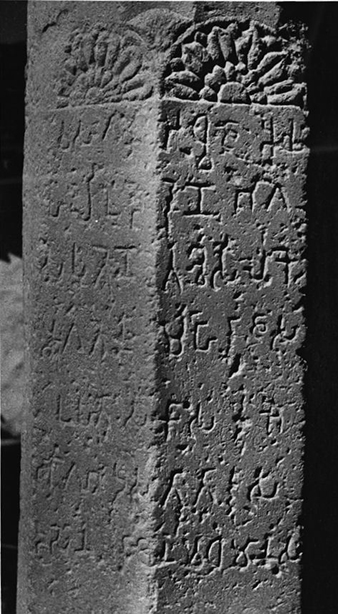
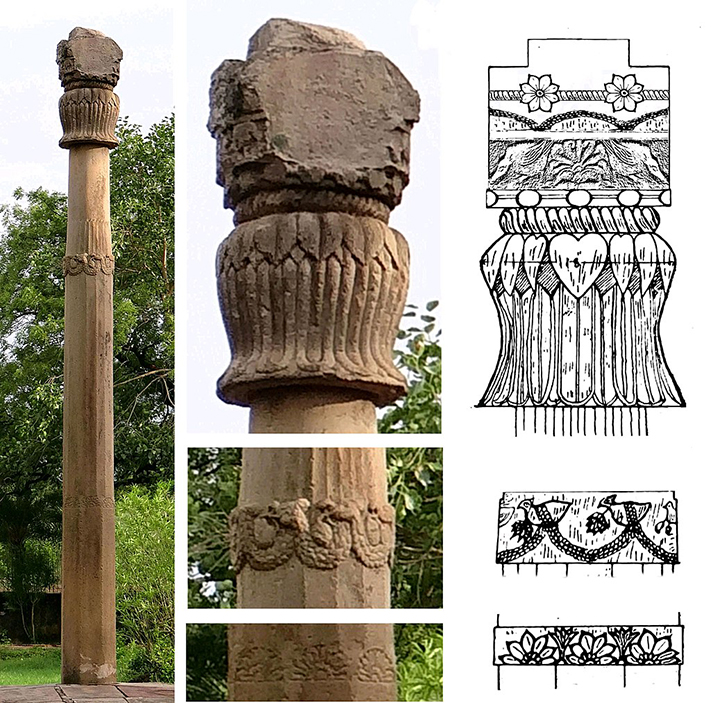
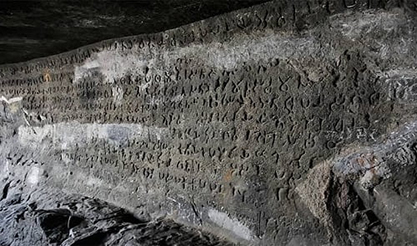
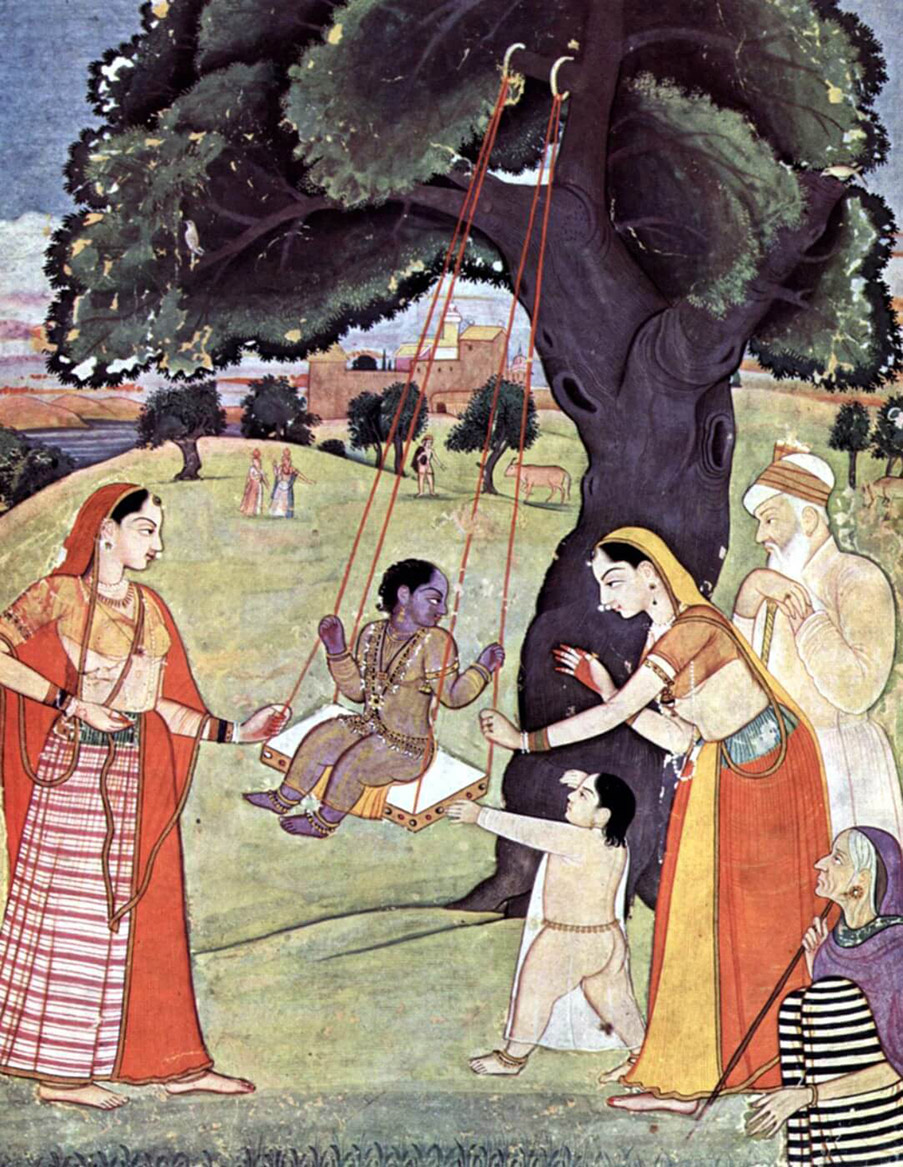
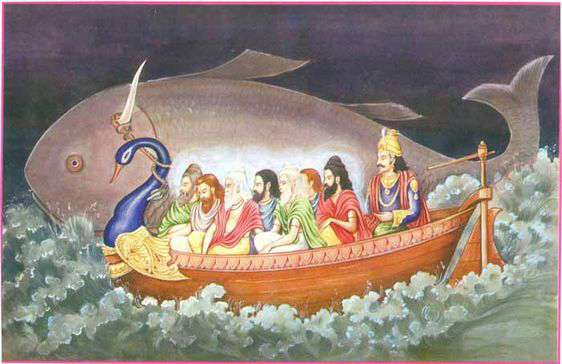

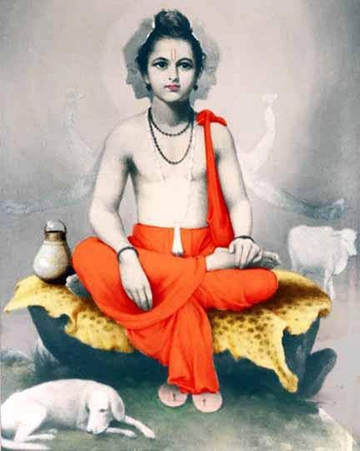


_03.jpg)







